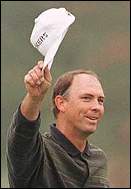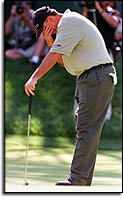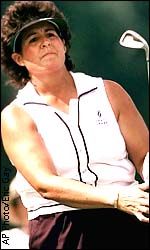Links
• Center
Field
• Love
of the Game
• Timeline
Today
• CF
Media
• E-mail |

The summer of 1997 in sports

BY NATHAN BIERMA
The chasm
that separates professional golfers from weekend
players seems in countless ways
unbridgeable. For professionals
golf is a business-like job,
for weekend players an addicting
hobby. Pros play a new
immaculately manicured course each week;
weekend foursomes make the
same familiar tread over shaggy
fairways with the usual
group over and over. Professionals are
paid to hit a certain brand
of all-new, high tech golf clubs;
weekend players swing away
with a set costing less than a pro's
driver. PGA pros adhere
to the stuffy rules of competitive golf;
for many foursomes, one-stroke
penalties receive as much
attention as a Senate hearing.
In the bitter winter months, PGA
tournaments are casually
conducted amid vast vistas in the
temperate climates of the
West; many summer regulars putt across
their living room carpet
when the snow falls, pausing only to
stand by the window and
gaze mournfully at the sheets of white
enveloping everything, including
their treasured lush green
fairways. They are
every bit as different as a 3-wood and a sand
wedge. It is the same
game, but it might as well be played in
two different worlds.
A rare attempt to connect
these worlds was made at this
year's U.S. Open.
Tom Lehman was reflecting on his approach to
the 71st hole with the title
on the line, a mis-hit that found
the greenside water hazard.
"I'd have given anything for a
mulligan," he lamented.
Alas, the U.S. Open is galaxies
away from the world of
mulligans, and Tom Lehman,
golf's feel-good hero, remains without
a U.S. Open title after
coming so close in each of the past three
years.
If anyone accentuates the
difference between the PGA Tour
and duffers on the public
course on Saturdays, it is Tiger Woods.
It isn't even the untold
millions he rakes in as easily as his
caddy Fluff smooths over
a used sand trap; it is his eye-popping
swing. At age 21,
Woods weighs only 160 pounds, but has a hip
turn that could start a
lawn mower. In April he indeed mowed
down the hallowed fairways
of Augusta, winning the Masters by
twelve strokes in his first
major as a pro, signaling the birth
of a living legend.
Given the ease with which Woods won, many
wondered if the 21-year-old
could become the first player to win
a Grand Slam--all four majors--in
the same year, an unheard of
feat for most golfers, let
alone a rookie.
But the U.S. Open is not
only golf's toughest test, it is
its toughest teacher.
Once again, the USGA this year grew the
rough to jungle-like proportions
and changed two par-5's to par-
4's. That the course
was the longest in Open history seemed to
suit Woods, but, especially
in the Open, hitting it straight is
of far more importance that
hitting it long. Not only did Woods
find the rough too often,
his putting stroke deserted him. His
finish of 19th would be
considered tremendous for an average
rookie, but Woods has long
since been average.
So while the newcomer fell
short, three players very
familiar to the Open's final
round vied for the title on Sunday.
Ernie Els won in 1994 and
seems to threaten at every major.
Colin Montgomerie rode the
momentum of a career year to
Congressional and stayed
in the thick of things after falling
from a first-round lead.
And, perhaps more familiar to such
Sundays than anyone, was
Tom Lehman, still searching for his
first U.S. Open title.
 Fewer
surnames prove as appropriate as that of Tom Lehman. Fewer
surnames prove as appropriate as that of Tom Lehman.
Known as the lunch-pail
pro for his blue-collar approach to the
most white-collar of sports,
Lehman toiled in the gutters of golf
for years before defying
the odds and returning to the PGA Tour.
Veteran of minor and forgotten
tours and tournaments worldwide,
Lehman passed up a golf
coaching position at the University of
Minnesota, which would have
included renting skis to students, to
venture about as far from
the bitter Minnesota winters as
possible--the PGA Tour.
Given such a history, simply
making the cut in a major would
seem satisfactory, but Lehman
went beyond that to prove himself a
major force in championship
golf. After a close finish in the
1995 Masters, a blown lead
at the 1995 U.S. Open, and a 72nd hole
bogey to lose the 1996 Open
by one stroke, Lehman finally broke
through last July by holding
off Nick Faldo at the British Open
en route to collecting the
most earnings ever by a touring pro
and being named tour Player
of the Year and ranking number one in
the world. A long
way from the back roads of North Dakota.
Still he remained in search
of the elusive U.S. Open title,
trying to avoid becoming
the first player to lead three Opens
after three rounds and lose
them all. Contending with Els, a
former champion, and Montgomerie,
antagonist to the raucous
Congressional crowd, Lehman,
the good guy in golf, was clearly
the crowd favorite.
Called the best husband and father on the
PGA Tour, Lehman could not,
it would seem, taste bitter
disappointment on Father's
Day.
Lehman waged a classic back-and-forth
battle with Els and
Montgomerie through the
back nine. With the overseas two playing
the 18th and Els leading
by one stroke, Lehman lined up what set
up as a perfect approach
at the par-4 17th--ideal lie, yardage,
and pin placement for a
hooking 7-iron. That was when whatever
U.S. Open goblins with the
name  Tom Lehman
at the top of their Tom Lehman
at the top of their
hit list struck again; mis-hit,
and the ball plummeted painfully
into the water. Lehman
was left looking for a miracle--a chip
shot to save par or a hole-in-one
on the par 3 18th to force a
playoff. The goblins
had other plans.
Montgomerie, meanwhile, also
one behind Els at 18, pulled a
25-foot birdie putt to leave
the sweet-swinging Els the title.
Montgomerie has his own
history of near-misses at majors--a third
place finish at the 1992
U.S. Open, a playoff loss to give Els
his first Open in 1994,
and a playoff loss at the 1995 PGA
championship. Put
the 1997 U.S. Open up there for an
unceremonious Grand Slam.
Montgomerie disappeared and broke
down, not consoled by the
fact that the next major, the British
Open, would be played at
his home course, Royal Troon, which he
grew up playing.
But sad story number one
was Lehman. It didn't seem to sink
in for him as it had for
Montgomerie. In a predictably subdued
state of bewilderment, he
could only express confusion. "I must
still be lacking something.
I know I'm good enough to win one of
these," he said.
It is the mystery of majors--how
Els could seemingly
effortlessly collect a second
U.S. Open in four years, while
Lehman sees a third straight
slip slowly, agonizingly, from his
grasp. It was a week
that served as a reality check, bringing
superstar Woods back down
to earth, frustrating recovering
alcoholic John Daly, who
walked out in the first round, and
cruelly laying out for Tom
Lehman another long road, another
journey filled with potholes
and pitfalls, another way that seems
longer than anyone else
has to take, this one for the marquee
golf championship for which
he has toiled for so long.
U.S. Open contenders and
weekend hackers may indeed exist in
two intranscendable worlds,
but that Father's Day at
Congressional, Tom Lehman
didn't seem all that far away. Even
when he wins this prominent
championship someday, he will not
seem as typically mechanical
as Ernie Els did this year, or any
other champion in other
years. That where the intrigue lies with
this seemingly unintriguing
player. He is a bridge to the real
world, real golfers, real
golf, not simply because of his
frustration and failure,
for he has enjoyed tremendous success,
but because he reminds us
weekend golfers of ourselves, and how
we picture we would traverse
the fairways of professional golf
were we given such a chance--efficiently,
if not gracefully,
modestly, and appreciative
of being payed to play the game of
golf, worlds away.
The
name "U.S. Open" seemed to be becoming a misnomer as
Australian Graham Marsh followed
the South African Els's win by
outlasting another South
African, John Bland, for the U.S. Senior
Open, and Switzerland's
Annika Sorenstam moved out of the way for
England's Allison Nicholas
to lead after three rounds of the U.S.
Women's Open at Pumpkin
Ridge. That left Nancy Lopez as
America's last hope to prevent
an international sweep, but that
seemed the least important
reason everyone was cheering for her.
Lopez has long been
the queen of women's golf, with charisma
and personality rare to
the few other stars of the women's game.
She has racked up 48 wins
in over two decades as a pro, capturing
the hearts of fans and adding
to their number. She had been
relatively quiet this decade
after essentially shelving golf in
favor of her family and
hadn't won a 72-hole event since 1993--
but she reminded the sports
world of her presence with a victory
at a rain-shortened tournament
early this year. There was only
one thing missing in a seemingly
perfect golf career--a win at
the U.S. Open.
Annika Sorenstam was supposed
to be the story. The quiet
and efficient Swede had
won the last two Opens with relative
ease, and seemed in perfect
shape to be the first woman to three-
peat at the Open after a
Tiger-esque four wins on the LPGA this
year. Sorenstam is
a reluctant occupant of the spotlight--in her
teens she would intentionally
blow tournaments to avoid a victory
speech--and still seems
something of a disinterested dominator.
She cares about golf, all
right--she stores all her statistics
since 1989 in a laptop computer--but
she has not eagerly embraced
a role as LPGA ambassador
or rival of fellow star Karrie Webb.
On the course, though, there
often seems to be no stopping her.
If any place suited itself
to a historic three-peat, Pumkpin
Ridge by history alone would
seem a good candidate. Less than
one year ago an amateur
named Tiger Woods roared back from behind
to win a third straight
U.S. Amateur title before turning pro and
promptly turning legend.
The course is by no means easy; it is
peppered with par-5's and
rough requiring a weedwacker to manage.
The 18th hole is a particularly
treacherous par 5 with a tee shot
over a miniature forest
to a bunker-spotted fairway, setting up
a second shot over another
stretch of foliage to a green guarded
by...more bunkers.
 She
struggled to explain it, but just as noiselessly and She
struggled to explain it, but just as noiselessly and
systematically as she won
the previous two Opens, Annika
Sorenstam promptly worked
her way out of contention and missed
the cut after two rounds
at Pumpkin Ridge. The hole that stood
out was the 9th in the first
round. Sorenstam drove into a
bunker, buried her approach
in a patch of rough, chopped it a few
feet, and eventually three-putted
for a triple bogey. She was
five over par after just
nine holes, unbelievable for the bulls-
eye player. 27 holes
later, she was out of the tournament,
trying to remember what
she did 62 tournament weekends ago, the
last time she missed a cut.
At the top of the leaderboard
in her place was England's
Allison Nicholas, all five
feet tall of her. Pounding drives
down the fairway and holing
putts from another zip code, Nicholas
was on pace to break the
record for lowest score in a U.S. Open,
by a male or female.
So was Nancy Lopez.
She seemed to come from nowhere to turn
back the clock and shoot
three rounds in the 60's, the only one
in the field to do so.
No U.S. Open player had ever shot four,
but as Sunday's final round
began, that was not her chief
concern.
*
* * Pending completion * * *


The Summer of 1997 in Sports
Hockey:
Triumph and Tragedy
Basketball:
One for the ages, again
Boxing:
Dismemberment and disgrace
Golf: Two tough to take |



